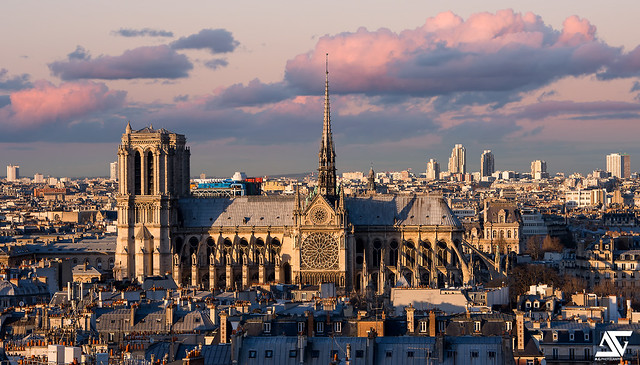
The fire at Notre-Dame naturally attracted a flurry of heartfelt reactions, moving testimonials and, inevitably, controversy. The commotion almost eclipsed the fact that damage and destruction are part of every building’s life cycle. Wear and tear, accidents and repurposing sooner or later make maintenance, reconstruction or razing inevitable. Most of the time, that work is just a routine requirement. But when the building in question is a historical landmark, the discussion becomes much more politically charged. Historical monuments are teeming with symbolism – even though the representations they conjure up sometimes vary and are often difficult to tally. So it’s not easy, at this point, to agree on the best technical solution, be it traditional heritage restoration, contemporary construction processes or something in between. We took a trip back in time to find inspiration.
Ancestral methods to renovate heritage
The Church of Our Lady in Dresden, the Stari Most in Mostar (Bosnia and Herzegovina) and the Sungnyemun in Seoul are examples of ‘identical’ reconstruction. The goal, here, is to protect heritage, to keep the building in its ‘ideal’ condition using its original materials and techniques. The project at the medieval Château de Guédelon doesn’t involve reconstruction, strictly speaking, but the principle is the same: it is based on period records and nothing but medieval methods, in this case for educational purposes. This true-to-history approach tallies with the principles in the international charters for conservation and restoration and the rules for Unesco sites. The oldest of these charters states that “The intention in conserving and restoring monuments is to safeguard them no less as works of art than as historical evidence.”
At the far end of the true-to-history spectrum is the option to quite simply do nothing. This decision often involves buildings damaged during wartime and the point is to draw attention to the ravages of war rather than the building’s integrity. The damaged belfry at Kaiser Wilhelm Memorial Church in Berlin and Genbaku Dome in Hiroshima are stirring monuments for peace. But even these more extreme cases need at least some technical work (which of course has to be as inconspicuous as possible). The Hiroshima Peace Memorial, for example, has been reinforced with epoxy resin and steel beams, and must be inspected every three years.
Restoration using contemporary methods?
The romantics may want to see ivy covering Notre-Dame’s walls or the sun shining on its golden cross, but that will probably not happen. The cathedral will be rebuilt. And even if the decision is to rebuild it exactly as it was, traditional methods will probably not be enough.
Even before the actual work starts, the structural inspections can use state-of-the-art technologies. Uavia offers drone-mounted inspection systems to identify outer damage with a very high degree of accuracy. Leica Geosystems’ Cyclone is offering cloud point technology to create 3D models. Back in 2010, historian Andrew Tallon scanned Notre-Dame’s entire structure using this system.
The reconstruction phase itself can involve a plethora of technical options, which will mostly depend on the challenges associated with each part of the project. Most longstanding buildings have changed over the centuries, so it’s not easy to freeze an image of the ‘ideal’ point in time and then aim to replicate it during restoration. And ‘identical’, in any event, is a bit quixotic. Notre-Dame’s head architect, Benjamin Mouton, has pointed out the difficulties associated with doing that and insists that the important thing is to keep the building’s silhouette rather than create an exact replica. When the Parliament of Brittany building in Rennes was rebuilt, laminated timber and metal beams were used “for structural reasons and expediency,” Marie-Line Quéro, an engineer at the culture and heritage office in Brittany, told Le Monde. On the other hand, Château de Lunéville opted for traditional solid pine and oak to recreate its meticulously documented 18th-century roof structure. Collège des Bernardins, which used steel beams for its new roof, and Reims Cathedral, which now has a concrete roof frame, are two good examples of successful attempts to modernise venerable buildings.
An exciting array of new processes and techniques
Then there’s that enigmatic “contemporary architectural touch” Emmanuel Macron has asked for, and which has set off myriad interpretations ranging from architects’ opportunistic visions to light-hearted memes. It’s an opportunity for building professionals to (more or less adroitly) advertise state-of-the-art or even up-and-coming technologies. Architect Jean-Michel Wilmotte is talking about a carbon spire, metal roof structure and titanium roof (titanium is especially resistant). André Joffre, who founded Tecsol, a solar energy consultancy, told Les Echos about his plans for a rooftop solar power station. Concr3de, a Dutch company, is tendering 3D printing to recreate some of the components from the stones and ashes left behind by the fire. And NAB is suggesting an educational rooftop garden as a tribute to the destroyed roof structure (the original one had been dubbed “the forest”). None of these projects are likely to gain much traction given the conservative sentiment that typically prevails when this kind of accident occurs, but they are serving another nonetheless laudable purpose: they are introducing the general public to an exciting array of new processes and techniques!
The variety of examples also sheds light on the wide range of options and outlooks surrounding monument reconstruction. There obviously isn’t one ‘right’ solution. But new modelling technologies are providing leads that might just keep everyone happy. Creating digital 3D models of the most visited or most fragile monuments could soon open their doors to virtual visitors. Iconem, a specialist in digital 3D models of heritage sites, has already worked in Angkor and Aleppo. Closer to home, AGP has already looked into rebuilding Notre-Dame’s “forest” – and already has an extremely accurate pre-fire scan of it.
The idea is a bit like the one in archives: old buildings could become immortal – but, this time, on hard disks!


